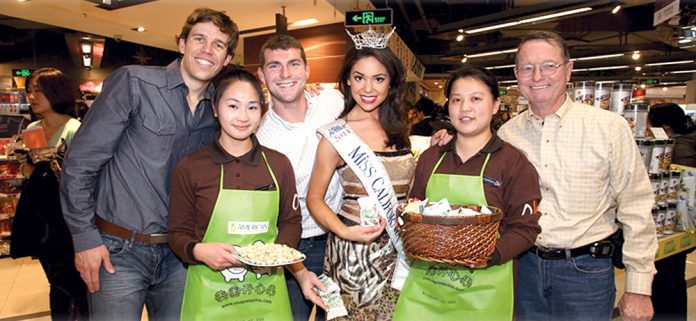
At the American Pistachio Growers’ most recent Annual Conference held in March, President Richard Matoian took the time to remind participants of the organization’s strategic plan and its strengths and opportunities.
“When you take your strengths and opportunities, that becomes your competitive advantage,” Matoian said. “I thought it was a good time to remind the membership of who we are, what we do and why we do it.”
In an interview with West Coast Nut magazine, he added that the organization’s strategic plan is applicable today and worthy of a look back.
In his presentation, Matoian addressed several strengths identified in the strategic plan, including that the voluntary organization has widespread participation and strength in numbers.
“I talked about the fact that our organization is voluntary in nature, but we represent the majority of the U.S. growers and that we are the only organization that represents growers across the three commercial states of California, Arizona and New Mexico.”
And, he said, the organization is driven toward common industry goals, which helps it wield a sizable influence in government affairs, marketing and other areas of concern to pistachio growers.
“We are not going to focus on a particular project that either this individual or maybe this state or maybe this part of the industry likes or wants,” he said. “We only work on those issues that are common to everyone and that make sense to the organization as a whole.”
Larger Crops
Another strength he identified is the increasingly larger pistachio crops being harvested as of late.
“While people may think that is a negative, for pistachios, because we have alternate bearing, having larger crops allows us to cover our customers one year to the next, and having that ability to be a consistent supplier around the world is important,” Matoian said. “At some point, that may not be the case, but for now, it still is an important attribute.”
And then there is the product itself. “We have a great product to sell,” Matoian said. “Consumers consistently rank pistachios as the number-one nut that they like to consume. However, the perception of them as being healthy is not the number-one reason. They still think other tree nuts are higher in healthy properties. They don’t see pistachios as being the healthiest tree nut, and we want to help change their mind. We want to continually improve what consumers see pistachios have on the health side.”
Among opportunities Matoian highlighted in his presentation was the opportunity to change consumer perception on a global level about the availability of U.S. pistachios.
“The U.S. has a steady and increasing supply of production,” he said, “so we can be the country that consumers around the world look to as we compete with Iran and Turkish product. So, we want to make sure that we help change consumer perceptions about the supply of our product, that it is readily available.”
The industry also has an opportunity to increase consumer perception of the health benefits of pistachios, he said. “We can continually improve on that and get people to recognize pistachios as a good, healthy snack item, and part of that will only come through nutritional research. So, we need to continually do more nutritional research to find out what are the healthy properties of our product.”
A Complete Protein
Judy Hirigoyen, vice president of global marketing for APG, said the organization has focused its marketing as of late on the fact that pistachios are one of the only plant-based sources of a complete protein, meaning it contains all nine essential amino acids.
“That is our number-one message: That pistachios are a complete protein. And it is an important message not only for consumers, but for governments,” she said. “Nearly every country we’re marketing in has a government sponsored campaign or nutrition guidelines that encourage consumers to get more of their protein from plants rather than animals. And since animal-sourced proteins are the primary source of the nine essential amino acids, the research showing pistachios are a complete protein is very meaningful. It means they’re more than just a snack.
“We have a lot of education to do globally about the health benefits of nuts, generally, and the place of pistachios in a sustainable diet, a plant-based or vegan diet,” Hirigoyen said. “These are considerations that are very important to consumers, most notably Europeans. And Europe is our number-one export market.”
Hirigoyen noted that APG marketing has been able to show definitive results in its global marketing in recent years.
“Since 2015-16 through 2021, which is the latest year for which data is available, the compound growth rate for pistachios in countries where APG has been doing its marketing is 35.9% annual growth rate,” she said. “The growth rate for pistachios in countries where APG does not market is 17.2%.
“This explains why APG’s activities are more focused on certain export markets than domestic. Our exports hover around 70% of the total shipments each year, and that is where the growth opportunities are greatest,” Hirigoyen said.
“It is clear that the strategy and our Marketing Communications Committee’s selection of which countries to focus our marketing on have been successful,” she said. “We have several of the industry’s leading processors and growers around the table when we establish these export market opportunities, and once established, we are in those countries long-term. That is how we achieve results.”
Matoian and Hirigoyen pointed out that APG also is always looking to expand its global reach by analyzing market potential in new markets, such as Saudi Arabia, which the organization has recently been targeting.
“Why Saudi Arabia? That is a small country, but they have always consumed pistachios from Iran. But now we have an opportunity to introduce them to the American product, and they are taking a liking to it,” Matoian said. “They are bringing in more product from the U.S.”

Strategic Partnerships
Matoian pointed out that strategic partnerships with organizations like the Nutrition Research Education Foundation (NREF) have been beneficial for pistachios in providing opportunities to fund nutritional research. The umbrella organization includes, among other commodity groups, almonds, walnuts, pistachios, hazelnuts, pecans and macadamia nut organizations, all of whom put money toward collective nutrition research on tree nut commodities.
“Even though we are doing our own individual nutritional research on our own commodity, we still feel that there is incredible benefit to combining all of our tree nut commodities together to do like-minded research in leveraging dollars from each organization,” Matoian said.
Launched in 2007, the APG is a relatively young organization, Matoian said, but is increasingly influential. Looking to its mission statement is important as the organization plots future strategies, he said.
“Our focus is embodied through our strategic planning mission statement, which is to ‘Collectively advance the American pistachio industry through research, promotion, advocacy and programs that directly benefit our members.’
“That really embodies what we do,” he said. “We are a group that collectively works toward advancing the industry in a cohesive manner.”
And reminding members of that once in a while is sometimes valuable, he said.
He added that the organization is planning to conduct a new Strength, Weakness, Opportunities and Threats (SWOT) analysis next spring after its 2023 annual meeting.










